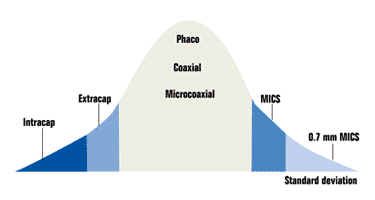What is the future of cataract surgery?
Looking at the history and current practice of cataract surgery through Gaussian distribution, one can see around the bend in cataract procedures.
 Jorge L. Alió |
The practice of cataract surgery has come a long way in the last 20 years. The development of the small incision concept, the use of phacoemulsification to implement this concept and the success of IOLs have led to continuous progress in a procedure that has created a boon in the quality of life of millions of people around the world. Cataract surgery has been one of the most important, if not the most important, surgical procedures successfully developed in the 20th century. The question now is what is next.
Gaussian distribution
When we place cataract surgery within the context of Gaussian distribution (Figure), it is clear that the standard of practice today is standard coaxial phacoemulsification. The majority of surgeons are still practicing phacoemulsification today. Surgeons practicing extracapsular extraction should be considered between the +2 to +2.6 standard deviation from the mean. Extracapsular 6-mm surgery is a procedure still in practice today, but rarely performed, hence between 2 and 2.6 standard deviation. It is still to be considered “normal” but in the limits of today’s practice.
Intracapsular cataract surgery is no longer a standard of practice and is no longer considered “normal,” and should be beyond the +2.6 mark of Gaussian distribution. It is clear that some years ago, intracapsular, then extracapsular and later phacoemulsification became the standard of practice. This demonstrates that the Gaussian curve is like a wave moving from left to right. So, let’s analyze what should be to the right in the Gaussian distribution.
There are some procedures outside the standard limits that are announcing the future. Microcoaxial (coaxial phacoemulsification performed through incisions of less than 2.2 mm), are being announced today as a way to reduce incision size and to increase the effectiveness of cataract surgery through reducing the impact on the cornea from an incision. This procedure is the limit of the progress of coaxial phaco. I doubt very much that microcoaxial will make any further evolution as far as it is, in my opinion, the end of a process that, even useful and brilliant today, has no way of evolving any further. Microincisional cataract surgery (MICS, a concept I created in 2001) consists of the division of functions between right and left hands. Irrigation and aspiration are used separately with new instruments that are able to allow surgical manipulation inside the eye through incisions of 1.5 mm or less. This is not a standard of practice today.
| Gaussian distribution of cararact surgery |
|
Source: Alió JL |
MICS
MICS should be considered beyond the —2 up to the —2.6 standard deviations of our Gaussian distribution. Amar Agarwal, MD, myself and others are now successfully practicing MICS and its variations with sub 1-mm incisions, down to 0.7-mm incisions. This is considered abnormal as practicing intracapsular surgery today. It is the limit of new cataract surgery procedures. I am not aware of any other type of procedure that can be performed through less than 0.7-mm incisions. This should be considered beyond the —2.6 standard deviation of our Gaussian distribution.
The wave of Gaussian distribution will ripple and move slowly but definitely toward the limits of coaxial phaco, and microcoaxial will be the standard of practice in the coming years. But MICS will be the standard of practice later, and what we could call sub 1-mm MICS or “micro-MICS” will be the next standard.
What is the limit of MICS?
It is clear to me that cataract surgery performed through punctures and not incisions will be the future. I am definitely convinced that the use of modern fluidics through the new pumps and probably new types of energy will allow us to perform a new type of “inside the capsule” surgery, removing the lens content while leaving the capsule intact. Whether the lens capsule will be used or not for optical purposes jointly with a gel or another material is still speculative. But lenses will come later.
A challenge to industry
The history of cataract surgery since Charles Kelman introduced the concept of small incision in early 1970 has remained relatively the same. Surgeons have been able to perform surgery through smaller incisions than the IOLs the industry could provide. Lens development always took several years to meet the surgeon’s skill level. Today, MICS lenses are available in many parts of the world and are as successful, if not more successful than regular standard coaxial small incision lenses.
Sub-1-mm lenses do not exist today and are not expected to be available in the immediate future. Indeed, the industry has a challenge, and they should pay attention to the movement of the wave of the Gaussian distribution of cataract surgery. This professional and sociological movement will tell them what is to be used in the future and what they have to research and develop to provide the surgeon with adequate intraocular optics to replace the human crystalline lens. It is clear that the future of cataract surgery can be anticipated today based on this logical framework.
For more information:
- Prof. Jorge L. Alió, MD, PhD, can be reached at Vissum, Instituto Oftalmológico de Alicante, Avda de Denia, s/n, 03016 Alicante, Spain; +34-965-150-025; fax: +34-965-151-501; e-mail: jlalio@vissum.com

